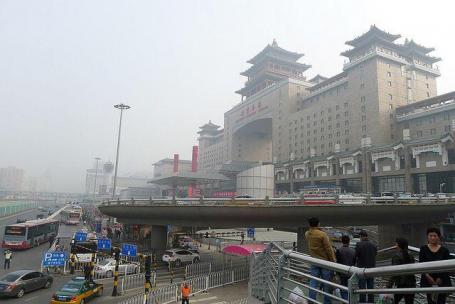World Water Day: How “Sludge” Can Power China’s Cities While Cutting Emissions

Last December, Beijing’s city government issued a “red alert” for smog levels—the highest possible designation. Schools and construction sites closed, traffic was restricted, and air pollution reached 10 times the World Health Organization’s recommended limit. Meanwhile, residents in neighboring cities went about their daily routines despite air quality ratings up to three times worse than Beijing’s, and coal-burning factories continued to run.
Devastating smog is a too-frequent occurrence in Beijing and across northern China—and an acute reminder of the dangers of China’s rampant coal use. The national government has committed to peak its emissions before 2030 and increase the share of non-fossil fuel energy sources to 20 percent of the national energy supply by 2030. It’s currently pursuing a portfolio of emissions-savings technologies to achieve these goals and shift away from fossil fuels like coal.
One unexpected place where China has a major opportunity to reduce energy demand and greenhouse gas emissions is through its wastewater treatment systems. Bioenergy wastewater treatment plant technology can both reduce China’s emissions and improve water quality, and the country is beginning to invest in this approach in a significant way.
This World Water Day, we’re highlighting this world-class example of technological innovation, environmental sustainability and sound economics aligning at the nexus of water, cities and energy. Bioenergy, or “sludge-to-power” treatment, is a solution that should continue to be a part of China’s emissions-reducing strategies—and an example for other cities around the world.
How Sludge-to-Power Works
Bioenergy plants work by converting the organic matter, or “sludge,” left over from treated sewage into electricity. The plant heats the solid waste, then employs microbes to digest it, which produce methane. The plant then burns that methane to generate power for water treatment. Excess methane can generate electricity for the facility, or power cars as a substitute for compressed natural gas (CNG). Leftover solid waste is sterilized, and can be used as fertilizer for certain types of crops. Other sludge-energy byproducts – called biochar – can be used to grow potted trees on landfill sites to restore landscapes or on city streets to help lower temperatures and improve air quality.
A WRI study recently analyzed the potential for sludge-to-energy systems in Xiangyang, China. After examining nutrient recovery, energy consumption, greenhouse gas emissions, reclaimed methane and cost of sludge disposal systems, we found that sludge-to-energy systems can make a positive environmental impact. They reduce solid wastes, greenhouse gases and water pollution, all while saving money. Selling fertilizer, biochar and even extra energy back to the grid can create new revenue for a wastewater treatment plant.
City managers should start to see sludge as a resource, rather than as a waste product, that they can incorporate into low-carbon development plans. This is particularly important because China’s wastewater treatment plants produce 30 million tons of sludge per year that must otherwise be hauled away by truck and disposed of. Bioenergy systems not only reduce those tons of solid waste that are usually spread on the land or in landfills, polluting streams and groundwater, they also reduce the greenhouse gases and other environmental impacts associated with thousands of truck trips to and from treatment plants.
A Growing Popularity in China
The idea is starting to take off in China. WRI’s study gave China’s Ministry of Housing and Urban-Rural Development science-based confidence to promote sludge-to-energy systems in other cities. A ministry official presented the benefits of sludge-to-energy systems at several major events in 2015 and early 2016 to audiences from wastewater and sludge management agencies, private companies from China and the United States, as well as international bilateral organizations. Last May, WRI hosted Chinese government officials from Beijing and other Chinese cities at DC Water’s Blue Plains sewage treatment plant in Washington, D.C. the first in North America to use an advanced Norwegian bioenergy system that is compact enough to fit in relatively cramped urban plants.
As a result of these and other efforts, four large cities in China—Beijing, Changsha, Chengdu and Hefei—began installing or are planning sludge-to-energy systems. Chengdu included five plants in its latest Five-Year Plan.
Based on WRI estimates, these plants collectively can help reduce 700,000 tons of emissions per year, comparable to one-third of the emissions produced each day by all the cars on U.S. roads. This relatively small contribution leaves plenty of room for improvement. Wastewater treatment in China produced more than 30 million tons of sludge in 2015. If 10 percent of that sludge was treated in a sludge-to-energy facility, the emissions reduction could reach 380 million tons of CO2/year, roughly equal to Ukraine’s emissions in 2012.
Additionally, the plants are expected to produce nearly 40 million cubic meters of compressed natural gas for taxis and city buses—enough to fill the tanks of 2 million taxis—while also powering the sludge disposal systems themselves.
These pioneering cities should be commended for their vision and investments, but many more lag far behind. WRI is now working with the World Bank and U.S. Environmental Protection Agency to promote sludge-to-energy in other places around the world. Turning sewage into power is a win for everyone involved, and presents an opportunity for hundreds of other cities.